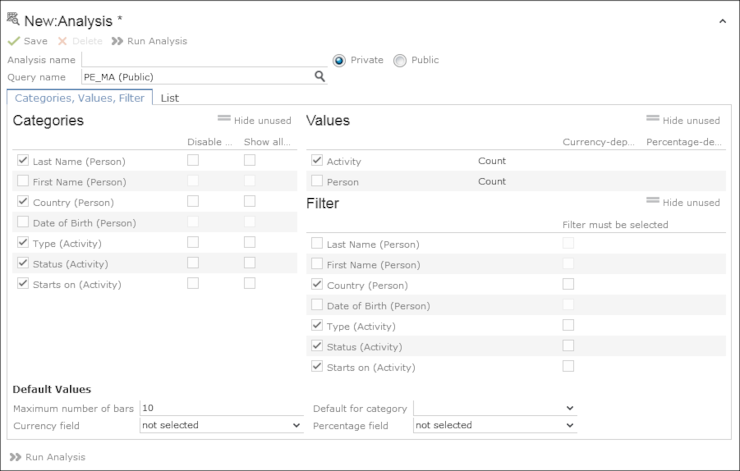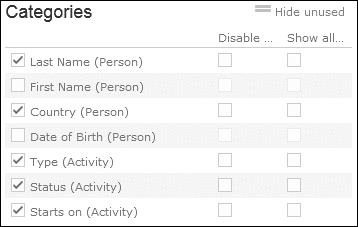Defining Analyses
Learn to define an analysis.
To define an analysis:
- Select
 (Queries & Analyses) > New Analysis and click on
(Queries & Analyses) > New Analysis and click on  (New).
(New). - The New: Analysis window is displayed.

- Enter the name of the analysis. You must enter a name to save the analysis.
- Determine whether the analysis is Private (only you can access it) or Public (anyone can access it).
- Click on
 (Select) next to the Query name field
and select the query to base your analysis on.
(Select) next to the Query name field
and select the query to base your analysis on.Various settings are displayed:

- Configure the settings as desired. Save the analysis.
The following settings options are available:
Defining Analysis Categories
To define the categories in an analysis:
- Define an analysis, see Defining Analyses or load an existing one.
- Define the categories in the Categories area:

- The following options are available:
- The output fields in the query are listed. Enable the check box on the left to determine the fields by which values in the analysis should be grouped.
-
Disable sorting of results: If this option is enabled,
values are not sorted.
If this check box is disabled, the results categories in the analysis are sorted according to the size of the result (sum total / average of the field values or number or records). This check box is only available for catalog values and date fields.
-
Show all values (even if value is 0): Enable this check
box to display categories even if their value is zero.Note: If this option is checked, the output result set also includes records that do not have a relevant record id. Example of such records include, left outer joins or group by aggregations (with optional, plus, plus summed).
Defining Analysis Values
To define the values in an analysis:
- Define an analysis, >> Defining Analyses or load an existing one.
- Define the values in your analysis in the Values area. Only
numeric values are listed, as only numeric values can be displayed in the analysis.
The following options are available:
- Use the check box to the left of the values to determine which values data can be analyzed by.
- Percentage-dependent: Enable this check box if you want to total all weighted values. You need to have selected a Percentage Field from the drop-down under Define Defaults Values for this setting to be applied.
- Currency-dependent: Enable this check box if you want to convert the contents of currency fields to the currency used by the analysis. You need to have selected a Currency Field from the drop-down list under Define Default Values for this setting to be applied.
Defining Analysis Filters
To define filters for an analysis:
- Define an analysis, >> Defining Analyses or load an existing one.
- Define the fields that can be used as filter criteria in the analysis in the
Filters area.

- The following options are available:
- Enable the check box to the left of a field to allow the field to be used a filter criteria in the analysis.
-
Filter must be selected: Enable this check box if a
value must be selected for the criteria selected under
Filter before the analysis is executed. Otherwise you
are informed that the analysis cannot be executed.
Use this option if too many records would otherwise be included in the analysis, in which case the analysis may take a long time to execute.
Defining the Analysis List View
After executing the analysis, you can select Display Details from the context menu in the results list to view a list containing the results of the analysis. You need to define which fields are displayed in this list beforehand.
To define the list view for an analysis:
- Define an analysis, see Defining Analyses or load an existing one.
- Click on the List tab.
- Define which fields are displayed in the list and their properties.

The following columns are available:
- No. in List: Enter the position (column number) of the value in the list.
- Width: Enter the column width as a percentage of the total width. The sum total of all widths should be 100%.